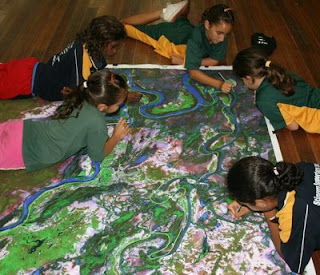This is to update you about a series of events which will focus on
Participatory GIS practice during the forthcoming
IUCN World Park Congress. The events we are organising have a common denominator:
Participatory 3D modelling (P3DM).
Below is a short description of the 3 events / activities:
Rolling activity (13-17 November), at the WIN & Pacific Community Dialogue Pavilion (Pavilion #2)
Title: Participatory 3D modelling of the traditional country of the Mandingalbay Yidinji People, Queensland, Australia
Organisers: Wet Tropics Management Authority with support provided by IUCN, CTA and UNDP Equator Initiative with financial support provided by UNDP GEF-SGP
Starting on 13 November and for the duration of the conference, representatives from the aboriginal Mandingalbay Yidinji People will work on a 3D Model reproducing their ancestral territory within the Wet Tropics World Heritage site. The model will be at a 1:10,000 scale and include terrestrial and coastal components. It will be a replica of a larger model completed by a wider representation of the community in Queensland with support provided by the Wet Tropics Management Authority, IUCN and UNDP GEF-SGP. The population of the 3D model with data will occur during the conference within the WIN Communities Dialogue Pavilion. Support in the process will be offered by Partners with Melanesians. The completed model will be presented by Mandingalbay Yidinji People during the Side event “: The risks and values of geo-referencing traditional and local knowledge” which will take in the same pavilion on Monday 17 (see below).
Pavilion event; 17 November 8:30 – 12:00, WIN & Pacific Community Dialogue Pavilion (Pavilion #2)
Title: Voices and Choices: The risks and values of geo-referencing traditional and local knowledge
Organisers: CTA and IUCN
Note: Coffee, tea and cakes will be served to participants by mid-morning
This event focuses on Participatory 3 Dimensional Modelling (P3DM) a method within the Participatory GIS family which enables communities to geo-reference and spatially document their complex systems of traditional land/seascape knowledge. The method benefits from its integration with GIS, multimedia production, Web2.0 and social media and serves multiple purposes, including landscape planning, rights advocacy, inter-generational knowledge transmission, influencing policy-making and enhancing communities’ socio-environmental resilience.
At the onset of Participatory GIS (PGIS) practice, concerns were expressed that the nature of and access to GIS would simultaneously marginalize or empower different groups in society. The practice evolved along different lines and among diverse interest groups. Currently it embraces a blend of applications ranging from Internet-based spatial multimedia to field-based participatory methods with a modest GIS component. In this fast-evolving context, there is a seemingly unstoppable excitement about georeferencing human physical, biological and socio-cultural worlds and making the information publicly available. This embodies both potentials and risks, aspects which need to be taken into consideration by knowledge holders, technology intermediaries/facilitators and researchers.
A physical 1:10,000 scale 3D model completed by the Mandingalbay Yidinji People representing a portion of their ancestral territory within the Wet Tropics World Heritage site in Queensland, Australia will be showcased at the event. Representatives from the community will share their experience in going through the various phases of the process, how they dealt with sensitive data, and their plans on how best to make use of acquired skills, knowledge and completed products (the model and derived maps) in their future endeavours.
Coordinator: Giacomo Rambaldi (rambaldi[at]cta.int)
Session within Stream 7; Tuesday 18 November 2014, 8:30 AM - 10:00 AM
Title: Knowledge management and technologies: Participatory 3D modelling in Protected Areas, landscapes and seascapes
Organisers: IPACC and CTA, in cooperation with Association des Femmes Peules Autochtones du Tchad, Minorités Pygmées du Gabon, and Yiaku People’s Association of Kenya, Melca Ethiopia and other indigenous peoples and local communities.
Background and summary: IPACC, African Biodiversity Network and other organisations have used Participatory 3 Dimensional Modelling (P3DM) to represent complex systems of indigenous landscape knowledge to themselves and decision-makers. P3DM, a geo-referenced and yet participatory system of knowledge representation serves multiple usages, including landscape planning, rights advocacy, inter-generational knowledge transmission and improving conservation.
The Technical Centre for Agricultural and Rural Cooperation (CTA) promotes skills transfer in P3DM for indigenous peoples and local communities in Africa, Caribbean and the Pacific regions.
Oral knowledge of biological systems emerges through the methodology, associated with resource governance, rights and indigenous values. The tool provides a multi-use medium for negotiating land use, understanding customary use systems, education for sustainability, and empowering indigenous peoples as holders of expert knowledge in conservation and planning.
P3DM case studies describe a broad range of ecosystems and contexts. P3DM provides a valuable tool for intercultural understanding of diverse knowledge and land use systems relevant for Protected Areas.
Coordinators: Nigel Crawhall (nigel.tilcepa[at]gmail.com) and Giacomo Rambaldi (rambaldi[at]cta.int)
 In April 2016 Djiru people began implementing a participatory 3-dimensional model (P3DM) covering close to 60,000 hectares (576 sq km) of land and sea, and including areas such as World Heritage, National Parks, freehold tenure.
In April 2016 Djiru people began implementing a participatory 3-dimensional model (P3DM) covering close to 60,000 hectares (576 sq km) of land and sea, and including areas such as World Heritage, National Parks, freehold tenure.








